Report: Critical Success Factors for Australian Construction Projects
VerifiedAdded on 2023/06/03
|10
|2220
|154
Report
AI Summary
This report delves into the critical success factors for managing stakeholders within Australian construction projects. It examines two case studies: the first analyzes energy-efficient housing in South Australia, considering factors like affordability and government initiatives. The second case study investigates reverse logistics implementation by South Australian construction organizations, focusing on waste reduction and environmental sustainability. The research employs a quantitative methodology, utilizing surveys and data analysis techniques like MS-Excel to gather and interpret data. The report concludes that while stakeholder management is vital, further research is needed to validate the findings and expand their applicability beyond South Australia. The report also highlights the importance of addressing cost barriers and improving reverse logistics practices to achieve sustainable construction outcomes.

1
Australian Construction
Australian Construction
Paraphrase This Document
Need a fresh take? Get an instant paraphrase of this document with our AI Paraphraser
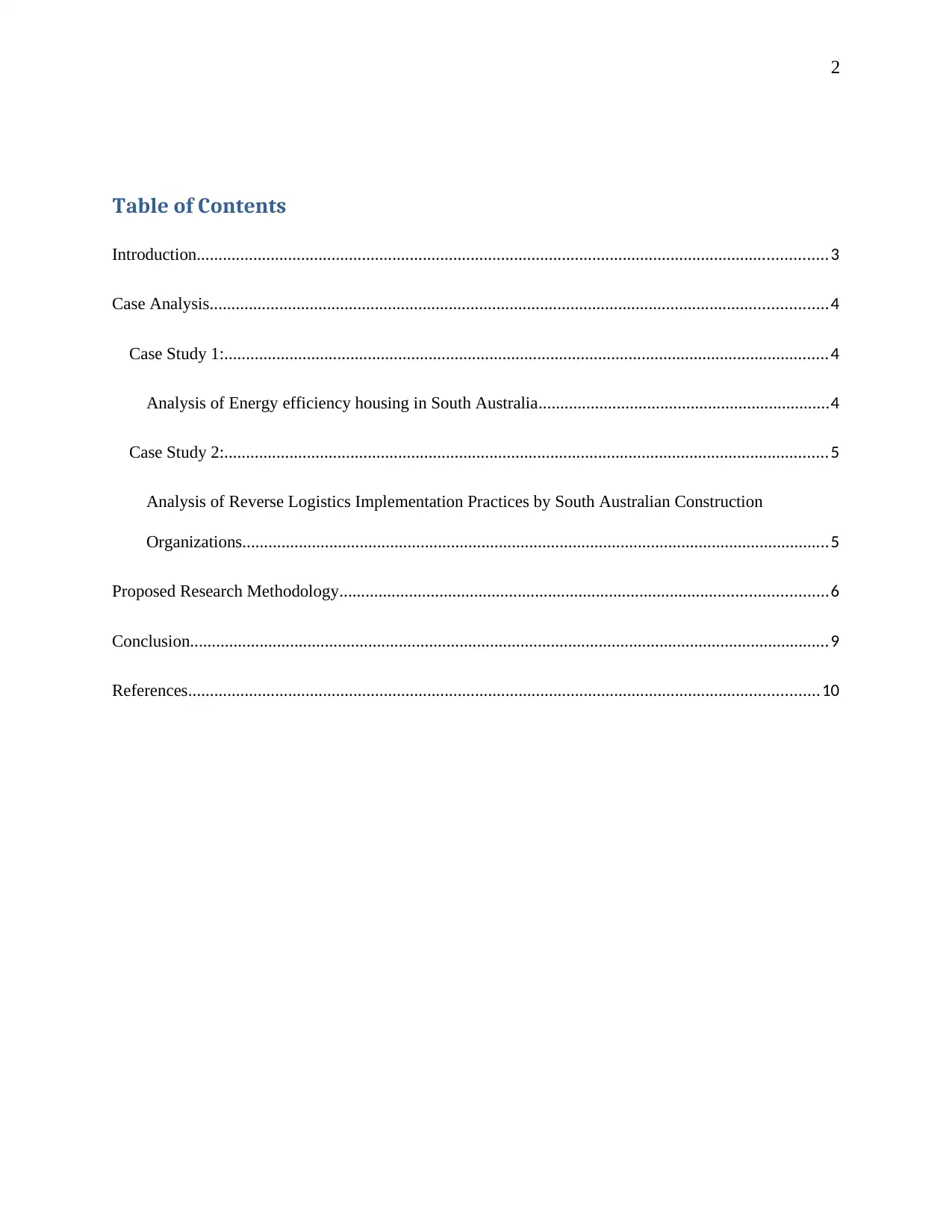
2
Table of Contents
Introduction.................................................................................................................................................3
Case Analysis..............................................................................................................................................4
Case Study 1:...........................................................................................................................................4
Analysis of Energy efficiency housing in South Australia...................................................................4
Case Study 2:...........................................................................................................................................5
Analysis of Reverse Logistics Implementation Practices by South Australian Construction
Organizations.......................................................................................................................................5
Proposed Research Methodology................................................................................................................6
Conclusion...................................................................................................................................................9
References.................................................................................................................................................10
Table of Contents
Introduction.................................................................................................................................................3
Case Analysis..............................................................................................................................................4
Case Study 1:...........................................................................................................................................4
Analysis of Energy efficiency housing in South Australia...................................................................4
Case Study 2:...........................................................................................................................................5
Analysis of Reverse Logistics Implementation Practices by South Australian Construction
Organizations.......................................................................................................................................5
Proposed Research Methodology................................................................................................................6
Conclusion...................................................................................................................................................9
References.................................................................................................................................................10
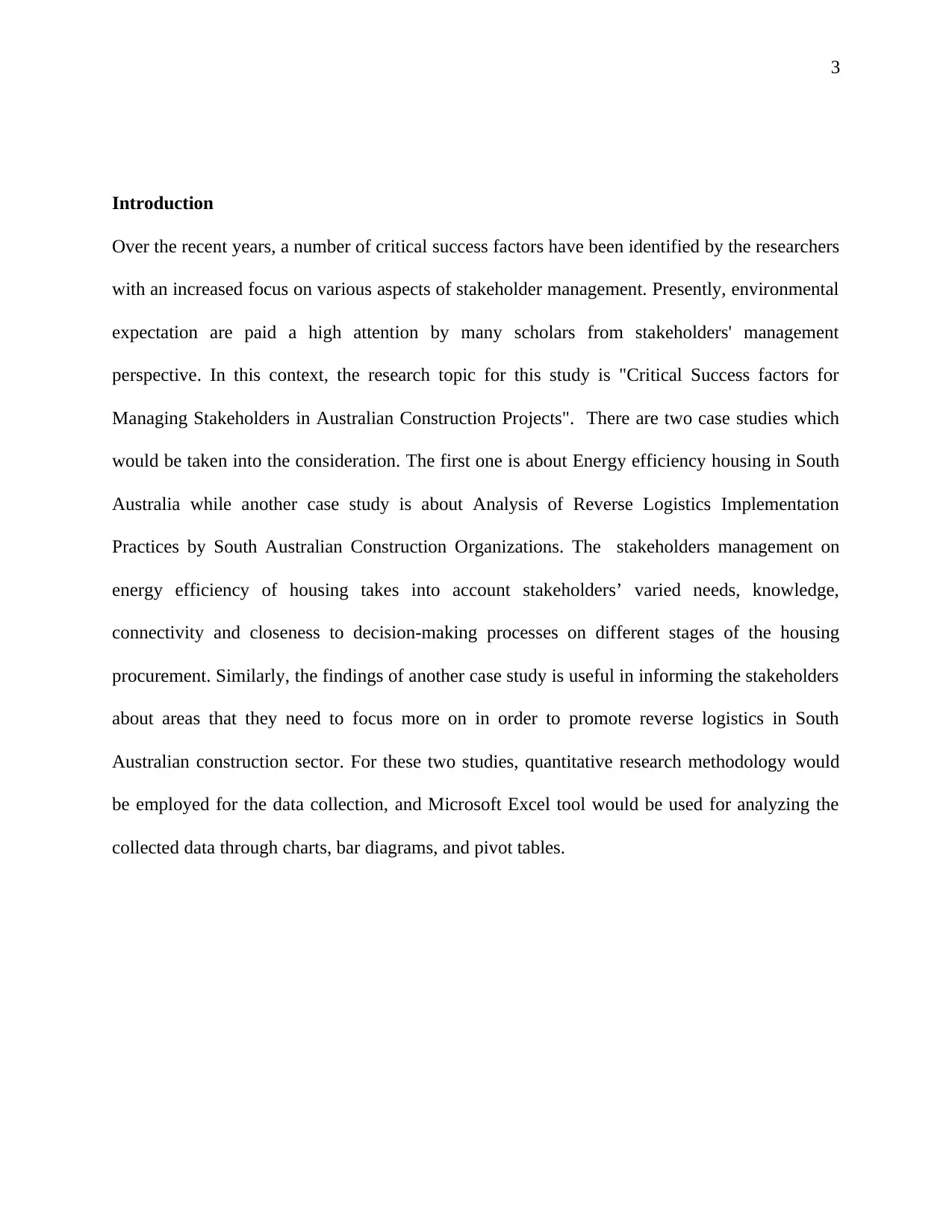
3
Introduction
Over the recent years, a number of critical success factors have been identified by the researchers
with an increased focus on various aspects of stakeholder management. Presently, environmental
expectation are paid a high attention by many scholars from stakeholders' management
perspective. In this context, the research topic for this study is "Critical Success factors for
Managing Stakeholders in Australian Construction Projects". There are two case studies which
would be taken into the consideration. The first one is about Energy efficiency housing in South
Australia while another case study is about Analysis of Reverse Logistics Implementation
Practices by South Australian Construction Organizations. The stakeholders management on
energy efficiency of housing takes into account stakeholders’ varied needs, knowledge,
connectivity and closeness to decision-making processes on different stages of the housing
procurement. Similarly, the findings of another case study is useful in informing the stakeholders
about areas that they need to focus more on in order to promote reverse logistics in South
Australian construction sector. For these two studies, quantitative research methodology would
be employed for the data collection, and Microsoft Excel tool would be used for analyzing the
collected data through charts, bar diagrams, and pivot tables.
Introduction
Over the recent years, a number of critical success factors have been identified by the researchers
with an increased focus on various aspects of stakeholder management. Presently, environmental
expectation are paid a high attention by many scholars from stakeholders' management
perspective. In this context, the research topic for this study is "Critical Success factors for
Managing Stakeholders in Australian Construction Projects". There are two case studies which
would be taken into the consideration. The first one is about Energy efficiency housing in South
Australia while another case study is about Analysis of Reverse Logistics Implementation
Practices by South Australian Construction Organizations. The stakeholders management on
energy efficiency of housing takes into account stakeholders’ varied needs, knowledge,
connectivity and closeness to decision-making processes on different stages of the housing
procurement. Similarly, the findings of another case study is useful in informing the stakeholders
about areas that they need to focus more on in order to promote reverse logistics in South
Australian construction sector. For these two studies, quantitative research methodology would
be employed for the data collection, and Microsoft Excel tool would be used for analyzing the
collected data through charts, bar diagrams, and pivot tables.
⊘ This is a preview!⊘
Do you want full access?
Subscribe today to unlock all pages.

Trusted by 1+ million students worldwide
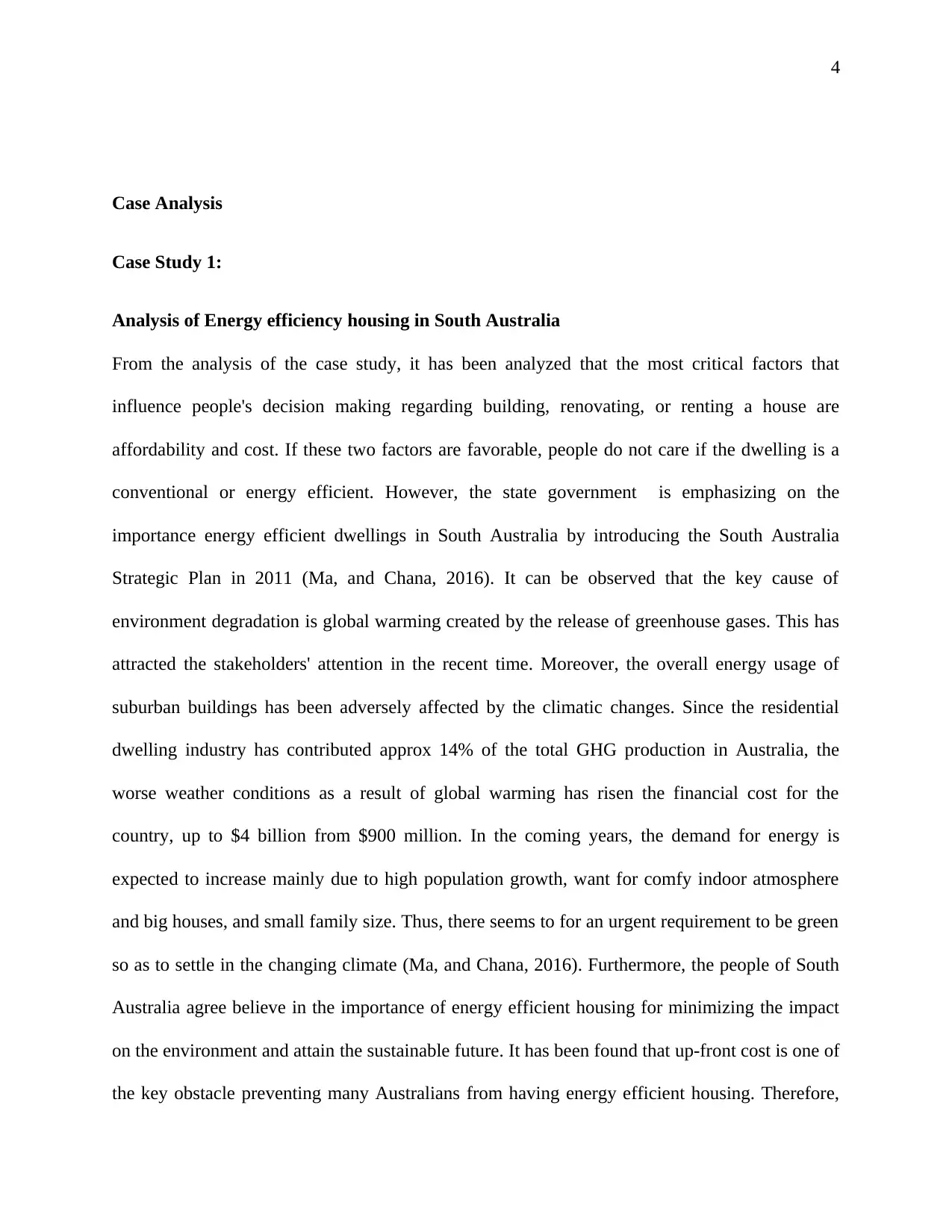
4
Case Analysis
Case Study 1:
Analysis of Energy efficiency housing in South Australia
From the analysis of the case study, it has been analyzed that the most critical factors that
influence people's decision making regarding building, renovating, or renting a house are
affordability and cost. If these two factors are favorable, people do not care if the dwelling is a
conventional or energy efficient. However, the state government is emphasizing on the
importance energy efficient dwellings in South Australia by introducing the South Australia
Strategic Plan in 2011 (Ma, and Chana, 2016). It can be observed that the key cause of
environment degradation is global warming created by the release of greenhouse gases. This has
attracted the stakeholders' attention in the recent time. Moreover, the overall energy usage of
suburban buildings has been adversely affected by the climatic changes. Since the residential
dwelling industry has contributed approx 14% of the total GHG production in Australia, the
worse weather conditions as a result of global warming has risen the financial cost for the
country, up to $4 billion from $900 million. In the coming years, the demand for energy is
expected to increase mainly due to high population growth, want for comfy indoor atmosphere
and big houses, and small family size. Thus, there seems to for an urgent requirement to be green
so as to settle in the changing climate (Ma, and Chana, 2016). Furthermore, the people of South
Australia agree believe in the importance of energy efficient housing for minimizing the impact
on the environment and attain the sustainable future. It has been found that up-front cost is one of
the key obstacle preventing many Australians from having energy efficient housing. Therefore,
Case Analysis
Case Study 1:
Analysis of Energy efficiency housing in South Australia
From the analysis of the case study, it has been analyzed that the most critical factors that
influence people's decision making regarding building, renovating, or renting a house are
affordability and cost. If these two factors are favorable, people do not care if the dwelling is a
conventional or energy efficient. However, the state government is emphasizing on the
importance energy efficient dwellings in South Australia by introducing the South Australia
Strategic Plan in 2011 (Ma, and Chana, 2016). It can be observed that the key cause of
environment degradation is global warming created by the release of greenhouse gases. This has
attracted the stakeholders' attention in the recent time. Moreover, the overall energy usage of
suburban buildings has been adversely affected by the climatic changes. Since the residential
dwelling industry has contributed approx 14% of the total GHG production in Australia, the
worse weather conditions as a result of global warming has risen the financial cost for the
country, up to $4 billion from $900 million. In the coming years, the demand for energy is
expected to increase mainly due to high population growth, want for comfy indoor atmosphere
and big houses, and small family size. Thus, there seems to for an urgent requirement to be green
so as to settle in the changing climate (Ma, and Chana, 2016). Furthermore, the people of South
Australia agree believe in the importance of energy efficient housing for minimizing the impact
on the environment and attain the sustainable future. It has been found that up-front cost is one of
the key obstacle preventing many Australians from having energy efficient housing. Therefore,
Paraphrase This Document
Need a fresh take? Get an instant paraphrase of this document with our AI Paraphraser
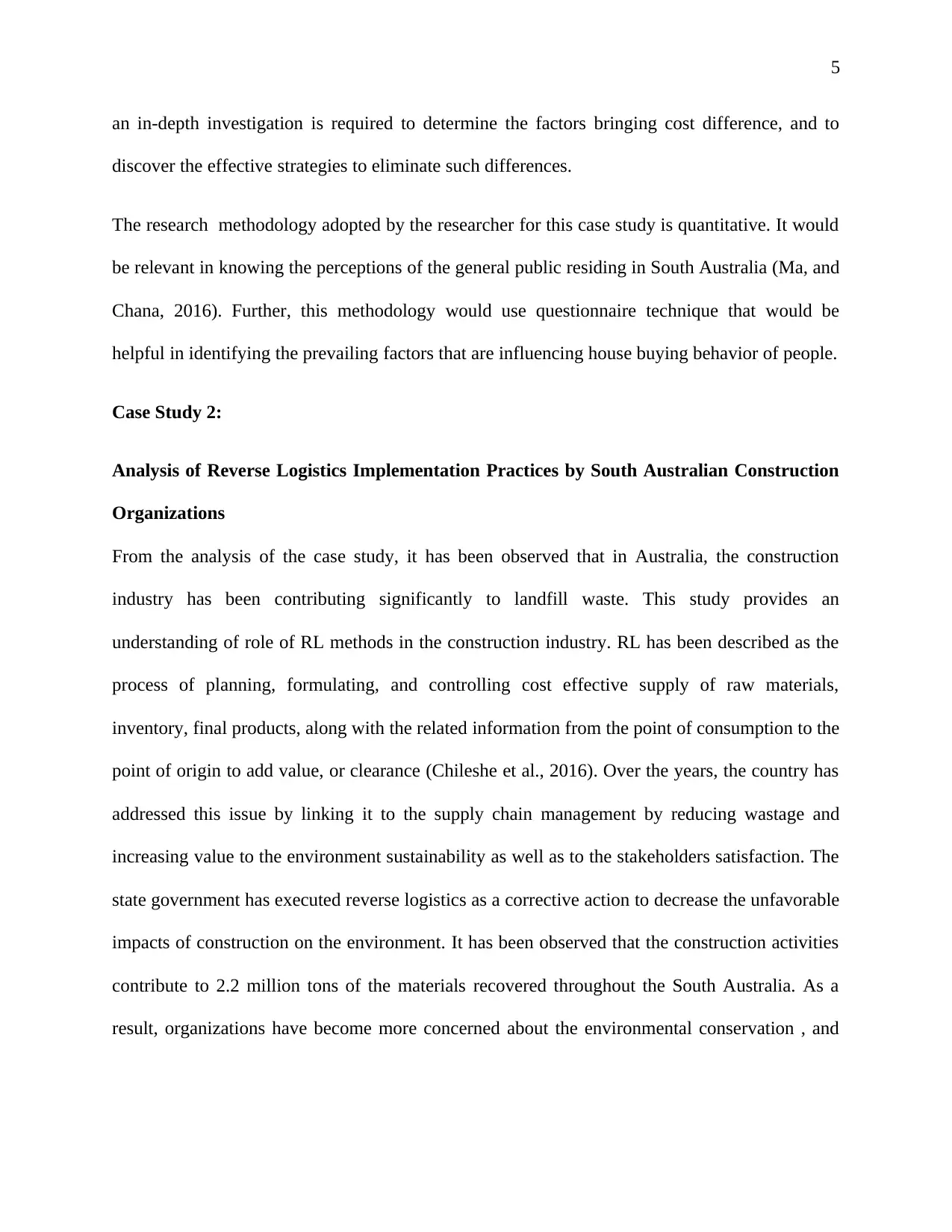
5
an in-depth investigation is required to determine the factors bringing cost difference, and to
discover the effective strategies to eliminate such differences.
The research methodology adopted by the researcher for this case study is quantitative. It would
be relevant in knowing the perceptions of the general public residing in South Australia (Ma, and
Chana, 2016). Further, this methodology would use questionnaire technique that would be
helpful in identifying the prevailing factors that are influencing house buying behavior of people.
Case Study 2:
Analysis of Reverse Logistics Implementation Practices by South Australian Construction
Organizations
From the analysis of the case study, it has been observed that in Australia, the construction
industry has been contributing significantly to landfill waste. This study provides an
understanding of role of RL methods in the construction industry. RL has been described as the
process of planning, formulating, and controlling cost effective supply of raw materials,
inventory, final products, along with the related information from the point of consumption to the
point of origin to add value, or clearance (Chileshe et al., 2016). Over the years, the country has
addressed this issue by linking it to the supply chain management by reducing wastage and
increasing value to the environment sustainability as well as to the stakeholders satisfaction. The
state government has executed reverse logistics as a corrective action to decrease the unfavorable
impacts of construction on the environment. It has been observed that the construction activities
contribute to 2.2 million tons of the materials recovered throughout the South Australia. As a
result, organizations have become more concerned about the environmental conservation , and
an in-depth investigation is required to determine the factors bringing cost difference, and to
discover the effective strategies to eliminate such differences.
The research methodology adopted by the researcher for this case study is quantitative. It would
be relevant in knowing the perceptions of the general public residing in South Australia (Ma, and
Chana, 2016). Further, this methodology would use questionnaire technique that would be
helpful in identifying the prevailing factors that are influencing house buying behavior of people.
Case Study 2:
Analysis of Reverse Logistics Implementation Practices by South Australian Construction
Organizations
From the analysis of the case study, it has been observed that in Australia, the construction
industry has been contributing significantly to landfill waste. This study provides an
understanding of role of RL methods in the construction industry. RL has been described as the
process of planning, formulating, and controlling cost effective supply of raw materials,
inventory, final products, along with the related information from the point of consumption to the
point of origin to add value, or clearance (Chileshe et al., 2016). Over the years, the country has
addressed this issue by linking it to the supply chain management by reducing wastage and
increasing value to the environment sustainability as well as to the stakeholders satisfaction. The
state government has executed reverse logistics as a corrective action to decrease the unfavorable
impacts of construction on the environment. It has been observed that the construction activities
contribute to 2.2 million tons of the materials recovered throughout the South Australia. As a
result, organizations have become more concerned about the environmental conservation , and
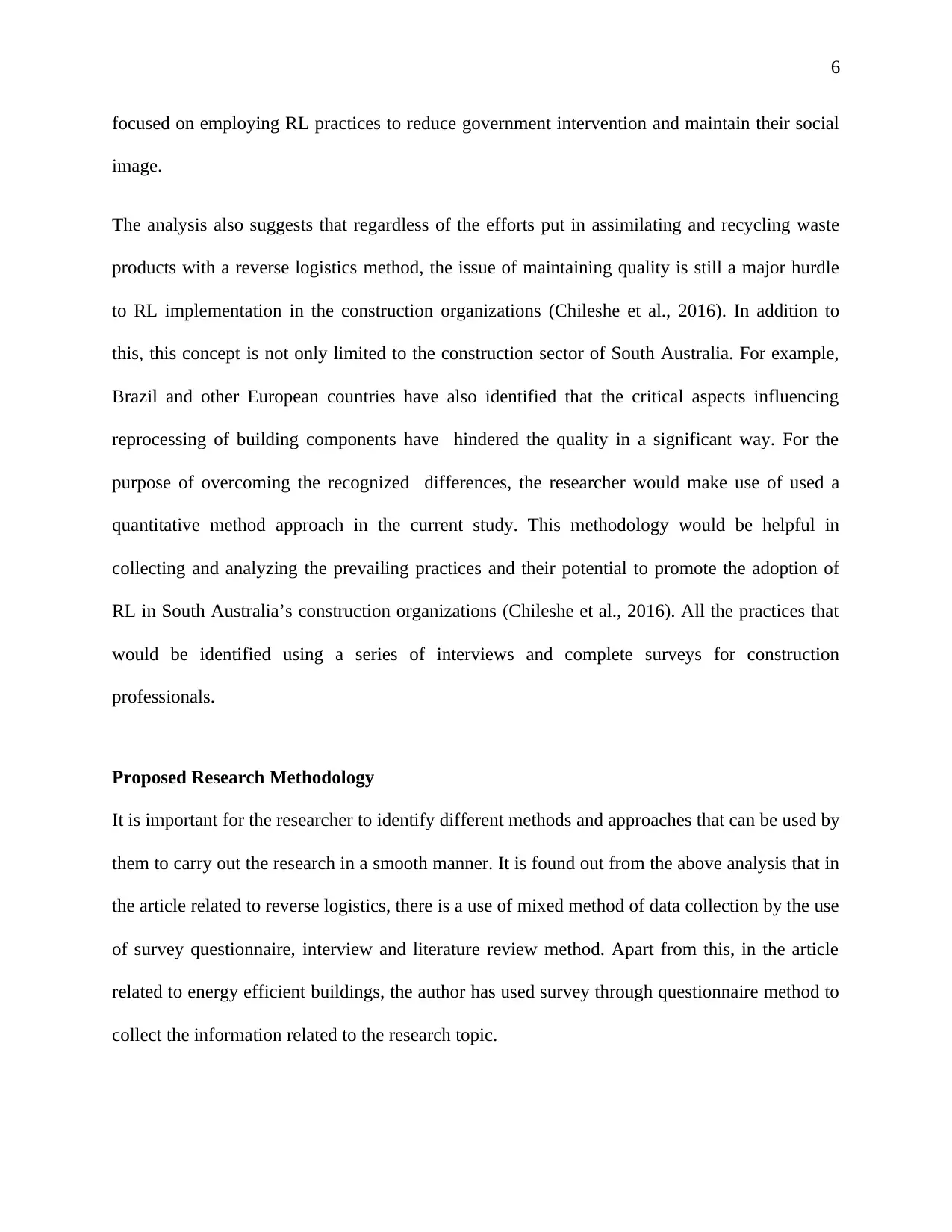
6
focused on employing RL practices to reduce government intervention and maintain their social
image.
The analysis also suggests that regardless of the efforts put in assimilating and recycling waste
products with a reverse logistics method, the issue of maintaining quality is still a major hurdle
to RL implementation in the construction organizations (Chileshe et al., 2016). In addition to
this, this concept is not only limited to the construction sector of South Australia. For example,
Brazil and other European countries have also identified that the critical aspects influencing
reprocessing of building components have hindered the quality in a significant way. For the
purpose of overcoming the recognized differences, the researcher would make use of used a
quantitative method approach in the current study. This methodology would be helpful in
collecting and analyzing the prevailing practices and their potential to promote the adoption of
RL in South Australia’s construction organizations (Chileshe et al., 2016). All the practices that
would be identified using a series of interviews and complete surveys for construction
professionals.
Proposed Research Methodology
It is important for the researcher to identify different methods and approaches that can be used by
them to carry out the research in a smooth manner. It is found out from the above analysis that in
the article related to reverse logistics, there is a use of mixed method of data collection by the use
of survey questionnaire, interview and literature review method. Apart from this, in the article
related to energy efficient buildings, the author has used survey through questionnaire method to
collect the information related to the research topic.
focused on employing RL practices to reduce government intervention and maintain their social
image.
The analysis also suggests that regardless of the efforts put in assimilating and recycling waste
products with a reverse logistics method, the issue of maintaining quality is still a major hurdle
to RL implementation in the construction organizations (Chileshe et al., 2016). In addition to
this, this concept is not only limited to the construction sector of South Australia. For example,
Brazil and other European countries have also identified that the critical aspects influencing
reprocessing of building components have hindered the quality in a significant way. For the
purpose of overcoming the recognized differences, the researcher would make use of used a
quantitative method approach in the current study. This methodology would be helpful in
collecting and analyzing the prevailing practices and their potential to promote the adoption of
RL in South Australia’s construction organizations (Chileshe et al., 2016). All the practices that
would be identified using a series of interviews and complete surveys for construction
professionals.
Proposed Research Methodology
It is important for the researcher to identify different methods and approaches that can be used by
them to carry out the research in a smooth manner. It is found out from the above analysis that in
the article related to reverse logistics, there is a use of mixed method of data collection by the use
of survey questionnaire, interview and literature review method. Apart from this, in the article
related to energy efficient buildings, the author has used survey through questionnaire method to
collect the information related to the research topic.
⊘ This is a preview!⊘
Do you want full access?
Subscribe today to unlock all pages.

Trusted by 1+ million students worldwide
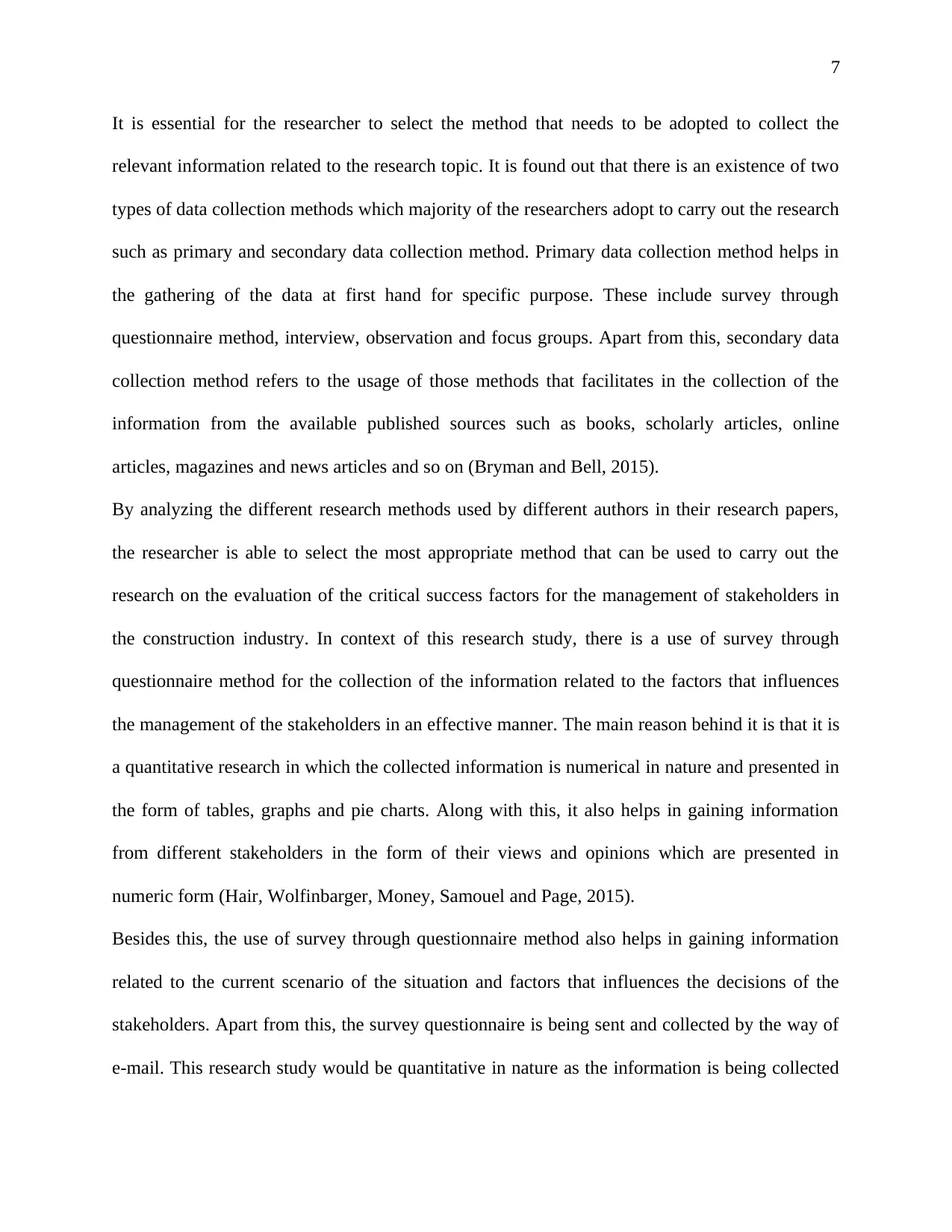
7
It is essential for the researcher to select the method that needs to be adopted to collect the
relevant information related to the research topic. It is found out that there is an existence of two
types of data collection methods which majority of the researchers adopt to carry out the research
such as primary and secondary data collection method. Primary data collection method helps in
the gathering of the data at first hand for specific purpose. These include survey through
questionnaire method, interview, observation and focus groups. Apart from this, secondary data
collection method refers to the usage of those methods that facilitates in the collection of the
information from the available published sources such as books, scholarly articles, online
articles, magazines and news articles and so on (Bryman and Bell, 2015).
By analyzing the different research methods used by different authors in their research papers,
the researcher is able to select the most appropriate method that can be used to carry out the
research on the evaluation of the critical success factors for the management of stakeholders in
the construction industry. In context of this research study, there is a use of survey through
questionnaire method for the collection of the information related to the factors that influences
the management of the stakeholders in an effective manner. The main reason behind it is that it is
a quantitative research in which the collected information is numerical in nature and presented in
the form of tables, graphs and pie charts. Along with this, it also helps in gaining information
from different stakeholders in the form of their views and opinions which are presented in
numeric form (Hair, Wolfinbarger, Money, Samouel and Page, 2015).
Besides this, the use of survey through questionnaire method also helps in gaining information
related to the current scenario of the situation and factors that influences the decisions of the
stakeholders. Apart from this, the survey questionnaire is being sent and collected by the way of
e-mail. This research study would be quantitative in nature as the information is being collected
It is essential for the researcher to select the method that needs to be adopted to collect the
relevant information related to the research topic. It is found out that there is an existence of two
types of data collection methods which majority of the researchers adopt to carry out the research
such as primary and secondary data collection method. Primary data collection method helps in
the gathering of the data at first hand for specific purpose. These include survey through
questionnaire method, interview, observation and focus groups. Apart from this, secondary data
collection method refers to the usage of those methods that facilitates in the collection of the
information from the available published sources such as books, scholarly articles, online
articles, magazines and news articles and so on (Bryman and Bell, 2015).
By analyzing the different research methods used by different authors in their research papers,
the researcher is able to select the most appropriate method that can be used to carry out the
research on the evaluation of the critical success factors for the management of stakeholders in
the construction industry. In context of this research study, there is a use of survey through
questionnaire method for the collection of the information related to the factors that influences
the management of the stakeholders in an effective manner. The main reason behind it is that it is
a quantitative research in which the collected information is numerical in nature and presented in
the form of tables, graphs and pie charts. Along with this, it also helps in gaining information
from different stakeholders in the form of their views and opinions which are presented in
numeric form (Hair, Wolfinbarger, Money, Samouel and Page, 2015).
Besides this, the use of survey through questionnaire method also helps in gaining information
related to the current scenario of the situation and factors that influences the decisions of the
stakeholders. Apart from this, the survey questionnaire is being sent and collected by the way of
e-mail. This research study would be quantitative in nature as the information is being collected
Paraphrase This Document
Need a fresh take? Get an instant paraphrase of this document with our AI Paraphraser
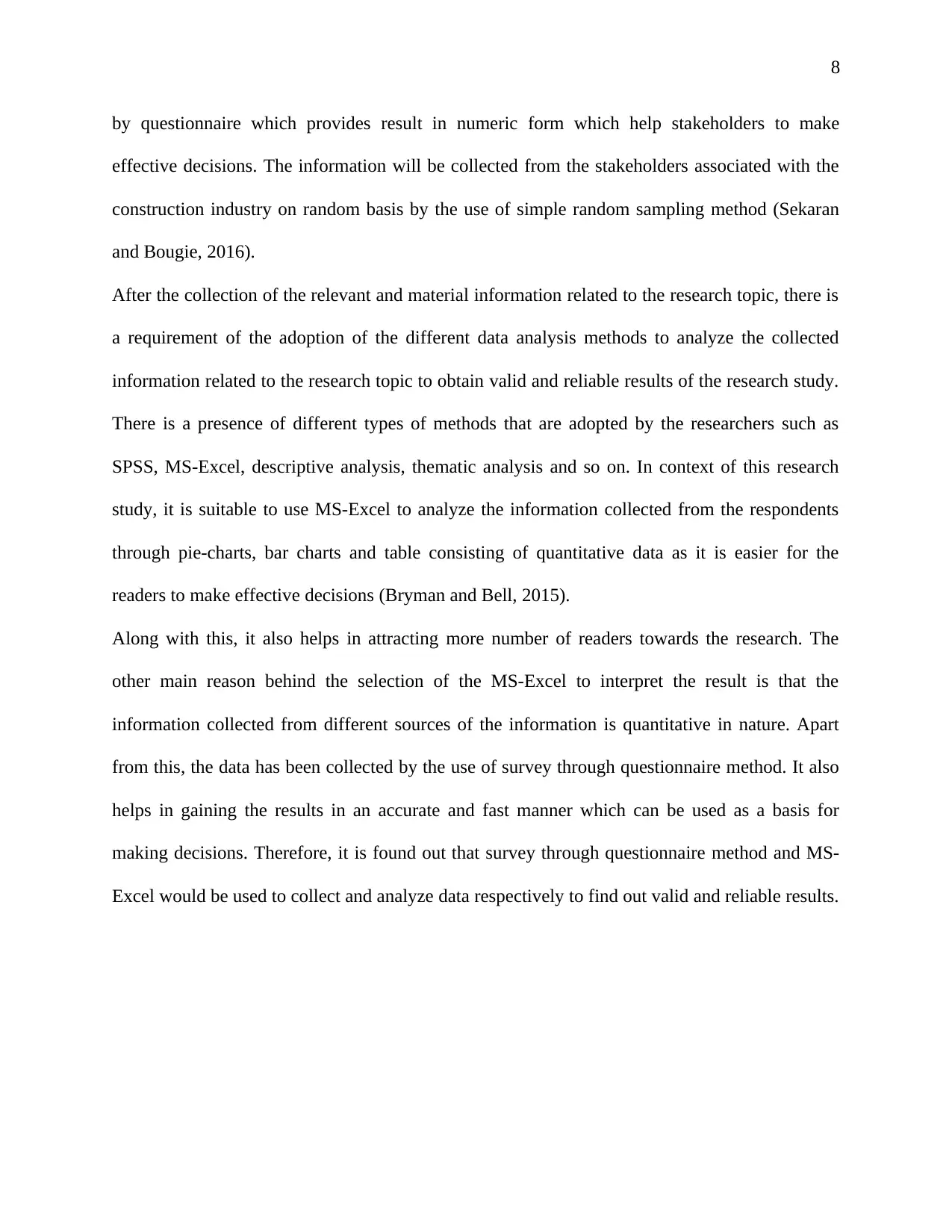
8
by questionnaire which provides result in numeric form which help stakeholders to make
effective decisions. The information will be collected from the stakeholders associated with the
construction industry on random basis by the use of simple random sampling method (Sekaran
and Bougie, 2016).
After the collection of the relevant and material information related to the research topic, there is
a requirement of the adoption of the different data analysis methods to analyze the collected
information related to the research topic to obtain valid and reliable results of the research study.
There is a presence of different types of methods that are adopted by the researchers such as
SPSS, MS-Excel, descriptive analysis, thematic analysis and so on. In context of this research
study, it is suitable to use MS-Excel to analyze the information collected from the respondents
through pie-charts, bar charts and table consisting of quantitative data as it is easier for the
readers to make effective decisions (Bryman and Bell, 2015).
Along with this, it also helps in attracting more number of readers towards the research. The
other main reason behind the selection of the MS-Excel to interpret the result is that the
information collected from different sources of the information is quantitative in nature. Apart
from this, the data has been collected by the use of survey through questionnaire method. It also
helps in gaining the results in an accurate and fast manner which can be used as a basis for
making decisions. Therefore, it is found out that survey through questionnaire method and MS-
Excel would be used to collect and analyze data respectively to find out valid and reliable results.
by questionnaire which provides result in numeric form which help stakeholders to make
effective decisions. The information will be collected from the stakeholders associated with the
construction industry on random basis by the use of simple random sampling method (Sekaran
and Bougie, 2016).
After the collection of the relevant and material information related to the research topic, there is
a requirement of the adoption of the different data analysis methods to analyze the collected
information related to the research topic to obtain valid and reliable results of the research study.
There is a presence of different types of methods that are adopted by the researchers such as
SPSS, MS-Excel, descriptive analysis, thematic analysis and so on. In context of this research
study, it is suitable to use MS-Excel to analyze the information collected from the respondents
through pie-charts, bar charts and table consisting of quantitative data as it is easier for the
readers to make effective decisions (Bryman and Bell, 2015).
Along with this, it also helps in attracting more number of readers towards the research. The
other main reason behind the selection of the MS-Excel to interpret the result is that the
information collected from different sources of the information is quantitative in nature. Apart
from this, the data has been collected by the use of survey through questionnaire method. It also
helps in gaining the results in an accurate and fast manner which can be used as a basis for
making decisions. Therefore, it is found out that survey through questionnaire method and MS-
Excel would be used to collect and analyze data respectively to find out valid and reliable results.
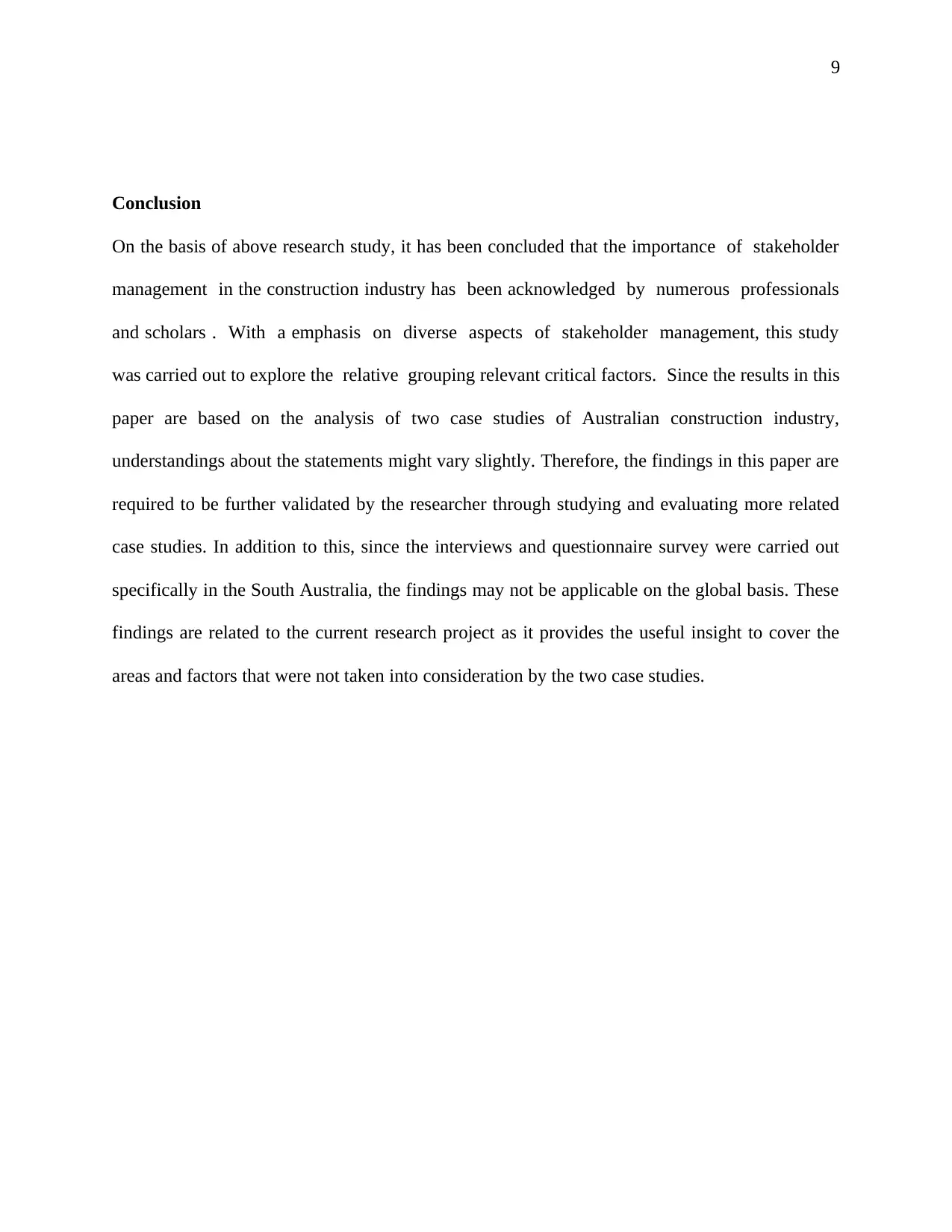
9
Conclusion
On the basis of above research study, it has been concluded that the importance of stakeholder
management in the construction industry has been acknowledged by numerous professionals
and scholars . With a emphasis on diverse aspects of stakeholder management, this study
was carried out to explore the relative grouping relevant critical factors. Since the results in this
paper are based on the analysis of two case studies of Australian construction industry,
understandings about the statements might vary slightly. Therefore, the findings in this paper are
required to be further validated by the researcher through studying and evaluating more related
case studies. In addition to this, since the interviews and questionnaire survey were carried out
specifically in the South Australia, the findings may not be applicable on the global basis. These
findings are related to the current research project as it provides the useful insight to cover the
areas and factors that were not taken into consideration by the two case studies.
Conclusion
On the basis of above research study, it has been concluded that the importance of stakeholder
management in the construction industry has been acknowledged by numerous professionals
and scholars . With a emphasis on diverse aspects of stakeholder management, this study
was carried out to explore the relative grouping relevant critical factors. Since the results in this
paper are based on the analysis of two case studies of Australian construction industry,
understandings about the statements might vary slightly. Therefore, the findings in this paper are
required to be further validated by the researcher through studying and evaluating more related
case studies. In addition to this, since the interviews and questionnaire survey were carried out
specifically in the South Australia, the findings may not be applicable on the global basis. These
findings are related to the current research project as it provides the useful insight to cover the
areas and factors that were not taken into consideration by the two case studies.
⊘ This is a preview!⊘
Do you want full access?
Subscribe today to unlock all pages.

Trusted by 1+ million students worldwide
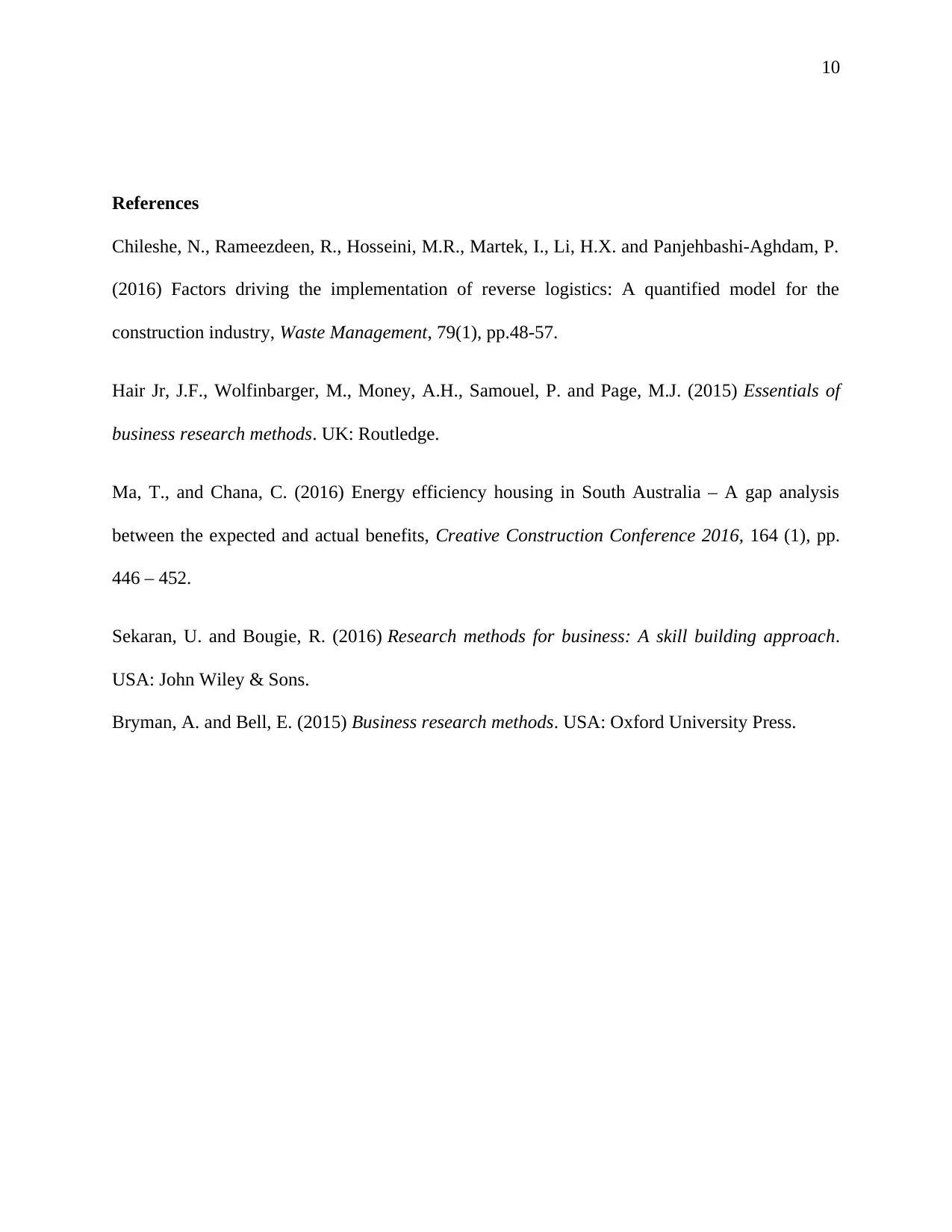
10
References
Chileshe, N., Rameezdeen, R., Hosseini, M.R., Martek, I., Li, H.X. and Panjehbashi-Aghdam, P.
(2016) Factors driving the implementation of reverse logistics: A quantified model for the
construction industry, Waste Management, 79(1), pp.48-57.
Hair Jr, J.F., Wolfinbarger, M., Money, A.H., Samouel, P. and Page, M.J. (2015) Essentials of
business research methods. UK: Routledge.
Ma, T., and Chana, C. (2016) Energy efficiency housing in South Australia – A gap analysis
between the expected and actual benefits, Creative Construction Conference 2016, 164 (1), pp.
446 – 452.
Sekaran, U. and Bougie, R. (2016) Research methods for business: A skill building approach.
USA: John Wiley & Sons.
Bryman, A. and Bell, E. (2015) Business research methods. USA: Oxford University Press.
References
Chileshe, N., Rameezdeen, R., Hosseini, M.R., Martek, I., Li, H.X. and Panjehbashi-Aghdam, P.
(2016) Factors driving the implementation of reverse logistics: A quantified model for the
construction industry, Waste Management, 79(1), pp.48-57.
Hair Jr, J.F., Wolfinbarger, M., Money, A.H., Samouel, P. and Page, M.J. (2015) Essentials of
business research methods. UK: Routledge.
Ma, T., and Chana, C. (2016) Energy efficiency housing in South Australia – A gap analysis
between the expected and actual benefits, Creative Construction Conference 2016, 164 (1), pp.
446 – 452.
Sekaran, U. and Bougie, R. (2016) Research methods for business: A skill building approach.
USA: John Wiley & Sons.
Bryman, A. and Bell, E. (2015) Business research methods. USA: Oxford University Press.
1 out of 10
Related Documents
Your All-in-One AI-Powered Toolkit for Academic Success.
+13062052269
info@desklib.com
Available 24*7 on WhatsApp / Email
![[object Object]](/_next/static/media/star-bottom.7253800d.svg)
Unlock your academic potential
Copyright © 2020–2025 A2Z Services. All Rights Reserved. Developed and managed by ZUCOL.





